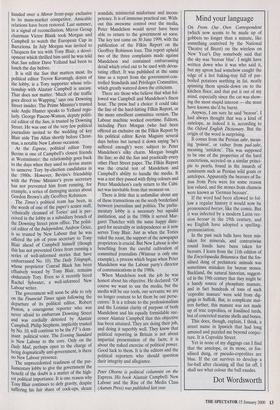Mind your language
On From Our Own Correspondent (which now seems to be made up of gobbets no longer than a minute, like something contrived by the National Theatre of Brent) on the wireless on New Year's Day somebody said that the sky was 'bezoar blue'. I might have written down who it was who said it, but my apron had somehow caught the edge of a hot baking-tray full of par- boiled potatoes seething in fat, neatly spinning them upside-down on to the kitchen floor, and that put it out of my mind, especially since the cat was show- ing the most stupid interest — she must have known she'd be burnt.
Anyway, I ant sure he said 'bezoar'. I had always thought that was a kind of antelope, as indeed it is, according to the Oxford English Dictionary. But the origin of the word is surprising. It comes from the Persian zahr, mean- ing 'poison', or rather from pad-zahr, meaning 'antidote'. This was supposed to be one of the properties of the hard concretions, secreted on a similar princi- ple to pearls, found in the innards of ruminants such as Persian wild goats or antelopes. Apparently the bezoars of lla- mas from Peru were for some reason less valued, and the stones from chamois were known as 'German bezoars'.
If the word had been allowed to fol- low a regular history it would now be pronounced beezer, like the comic. But it was infected by a modern Latin ver- sion bezoar in the 19th century, and we English have adopted a spelling- pronunciation.
In the past such balls have been mis- taken for minerals, and contrariwise round fossils have been taken for bezoars. I learn from the 11th edition of the Encyclopaedia Thitannica that the fos- silised dung of prehistoric animals was sometimes mistaken for bezoar stones. Buckland, the natural historian, suggest- ed in the 19th century that they might be a handy source of phosphate manure, and in fact hundreds of tons of such 'coprolite manure' were sold from dig- gings in Suffolk. But, to complicate mat- ters further, this manure was not made up of true coprolites, or fossilised turds, but of concreted marine shells and bones.
This does, though, explain, I think, a street name in Ipswich that had long amused and puzzled me beyond conjec- ture. It is Coprolite Street.
Yet in none of my diggings can I find that the antelope, or its stone, or fos- silised dung, or pseudo-coprolites are blue. If the cat survives to develop a fur-ball after cleaning all that fat off, I shall see what colour the ball exudes.
Dot Wordsworth


























































 Previous page
Previous page